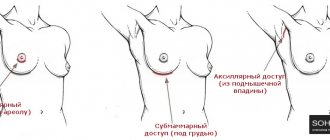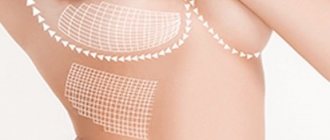1. Cost of the operation. 2. Indications for breast augmentation surgery. 3. Contraindications for breast augmentation. 4. Methods of breast enlargement. 5. Preparation for surgery. 6. Progress of breast augmentation surgery. 7. Rehabilitation after surgery. 8. Frequently asked questions about breast augmentation.
Contraindications for breast augmentation.
The main contraindications to breast augmentation surgery are:
- age up to eighteen years;
- chronic diseases during exacerbation and the presence of infectious diseases;
- diseases associated with blood clotting disorders;
- breastfeeding the child (at least 6 months must pass after the end of breastfeeding before breast augmentation surgery);
- presence of cancer;
- pregnancy period;
- heart disease and immune diseases (be sure to consult a doctor!)
Breast lift and implants
In a situation of sagging breasts and lack of volume, or after pregnancy, or with weak skin turgor, the question arises of both breast augmentation and lifting.
How compatible are two operations that are opposite in mechanism?
The purpose of mastopexy is to return the position of the mammary gland spot to a physiological position. And augmentations mean an increase in breast volume, which will inevitably lead to ptosis.
In this situation, the surgeon and the patient try to find a compromise between the desire to have a larger breast size and a stable long-term result with a minimal likelihood of correction.
The choice of technique depends on the degree of breast sagging, chest circumference, width of the mammary gland spot, skin turgor and density of glandular tissue.
Solutions:
Periareolar mastopexy - in this case, using access along the edge of the areola, implants are installed under the pectoral muscle or under the gland, and the size of the areola is reduced. One of the advantages of this access is the minimum number of stitches. The disadvantages include contouring the implant in the lower pole, especially with a thin coating.
This type of operation is used, as a rule, for a small degree of prolapse and overstretched areolas. Breastfeeding after this operation is possible, but some quadrants fall out of the feeding process.
In the case of nulliparous girls, access and installation of implants is performed from the side of the inframammary fold; the areolas are reduced only by excision of the skin, without involving the gland. In this case, the gland tissue will fully fulfill its purpose of feeding the child.
Vertical or T-shaped mastopexy with installation of implants.
This operation is performed only when there is noticeable prolapse of the gland tissue and the presence of excess skin. A feature of this technique is the need for stable coverage of the lower pole of the implants and the presence of excess gland tissue and skin cover that must be resected.
Moreover, the larger the initial volume of the gland, the more likely it is to slip from the installed implant, or along with it. Thus, the result of the operation may be ptotic breasts of a larger size than they were before the operation, which will require another corrective operation. And in this technique, it is important to maintain a balance between the size of the implant, its good coverage and the amount of tissue resection. Moreover, even if all these conditions are met, the probability of suture correction remains in the range of 6-12 months.
Another option is to divide the operation into two stages, in the first of which a vertical mastopexy is performed, and a few months later the implants are installed. It is used for initially pronounced ptosis and weak skin turgor. This combination of operations gives the most stable long-term results.
Breast enlargement methods
Methods of breast enlargement include breast augmentation using implants
and
breast augmentation with your own fat (breast lipofilling)
.
Breast augmentation with implants
is suitable for patients who have naturally small breasts and want to significantly change the size and shape.
Breast augmentation with fat
(breast lipofilling) is recommended for those who do not want drastic changes, but only want to correct and improve the shape of the breast.
Removal and replacement of breast implants: all about re-endoprosthetics
“Will I definitely have to change implants in 10 years?”
The question is so common that I decided to devote an article to it.
Every year more and more plastic surgeries are performed in the world. According to the International Society of Aesthetic Plastic Surgery (ISAPS), their number increased by more than a million from 2014 to 2015 alone. At the same time, procedures to correct the size and shape of the breast are leading in demand: almost 1.5 million such operations were performed in 2015 alone. Despite its worldwide popularity, in Russia breast surgery is still surrounded by myths and prejudices. For example, many people by default perceive plastic surgery solely as breast enlargement (although there are a great many operations in the breast area) or seriously believe that implants explode on an airplane.
Let's figure it all out.
According to world statistics, almost 20% of patients undergo repeated operations during the first 10 years after mammoplasty. Many people think that repeated operations are carried out mainly to correct some terrible complications or mistakes of plastic surgeons. In fact, such cases are the rarest reason for referral - about 3-4%. Even a quick glance at these figures should inspire confidence, not worry or fear, because it means that four out of five women have been enjoying all the benefits of beautiful breasts for well over 10 years. Modern implants themselves do not require replacement - manufacturers give them a lifetime quality guarantee.
Why do women undergo revision breast surgery?
The main reasons for repeated breast surgery:
- Replacing old implants with models of a different size or with more modern products from another manufacturer
- Repeated breast surgery after childbirth (with or without replacement of implants - according to indications)
- Removal of breast implants at the request of the patient (wants to return to the original appearance that was before the operation) - in my practice this has only happened once.
- Correcting the results of unsuccessful breast surgery:
a fairly large group of defects that require repeated surgery to correct. These include: asymmetrical location or displacement of implants, their protrusion or collapse, position that is too high or low, the appearance of folds and wrinkles on the chest, obvious palpation of endoprostheses through soft tissue, the formation of a double breast contour, etc. (with or without replacement of implants - according to indications)
- Postoperative complications
- capsular contracture (implant replacement is always required);
- contouring the edges of implants or “waves” on the chest (most often, replacement of implants is required);
- rejection or infection.
In all of the above cases, surgical correction can give an excellent result that will completely satisfy the patient.
Let's look at each point in detail:
Regarding points 1-3: Dissatisfaction with the aesthetic result of the primary operation
Most often, this is caused by quite obvious problems, for example, implants that are incorrectly selected in size or shape, but sometimes it is simply a matter of subjective dissatisfaction with certain parameters of one’s new bust.
The need to correct changes in the appearance of the breasts caused by sudden fluctuations in weight, pregnancy, age-related factors, etc. Also, one cannot ignore the fact that after a certain time after endoprosthetics, the shape of the breast may deteriorate. This can happen after 10-15 years, sometimes even more, but it happens almost inevitably: under the influence of gravity, the implants shift, stretching the breast tissue, and a new visit to the plastic surgeon will be needed to restore its former shape.
The patient’s desire to enlarge her breasts by 3-4 or more sizes. Technically this is possible, but plastic surgeons consider an increase of no more than 1-2 sizes in one “approach” to be optimal. In this case, it is possible to avoid breast deformation, overstretching of soft tissues, the appearance of stretch marks, complications with the spine due to significantly increased weight and a shift in the center of gravity.
Regarding point 4, read my article “How to choose a plastic surgeon” and find a truly experienced surgeon in mammoplasty (sometimes they also do operations on promotions)))
Everything is clear here, but point 5 requires professional clarification. Plastic surgery is a surgical intervention on the body and, as with any operation, postoperative complications may occur (probability 3-4%)
Removal of breast implants is necessary if complications of mammoplasty develop:
- Inflammation
- Infection
- Bleeding
It is important to note that we are talking about inflammation/infection in the area of the implantation pocket. Minor inflammation of the postoperative scar does not require surgical revision. In case of damage to deep tissues, as well as in case of implant rupture due to chest trauma, removal of endoprostheses is mandatory. Repeated mammoplasty is performed only after complete restoration of the gland.
Removal and replacement of breast implants
Removal with simultaneous replacement of implants is indicated for the development of obvious aesthetic defects after primary mammoplasty. Such defects include:
- Capsular contracture
- Breast deformation and asymmetry due to implant displacement
- Explicit contouring of the implant
- Formation of a double breast contour
Contouring of the implant and the formation of a double contour of the gland can result from the installation of too large implants. To avoid this, surgeons recommend enlarging the bust in two stages with re-endoprosthetics. Pregnancy, lactation, rapid weight loss and age-related changes in soft tissue can also cause a deterioration in the aesthetic value of primary mammoplasty.
There is always a minimal risk of developing capsular contracture , but with the advent of new generation implants with a textured shell, this complication is becoming less common. Displacement of the implant, which leads to deformation and asymmetry of the breast, can be caused by both a violation of the arthroplasty technique and improper behavior of the woman during the rehabilitation period.
And finally. The implants are strong enough that you can do any sport you want: scuba diving, mountain climbing, even boxing. The main thing is not to do this immediately after surgery (the recovery process can take from two weeks to six months). In my practice, complications occurred when women flew to sea a month after the operation. We swam, sunbathed, and played active sports. Of course, you really want to show off your new forms as quickly as possible, but following the recommendations of the operating surgeon is the key to successful recovery after surgery and your health in general. When exactly you can return to an active lifestyle and sports - your doctor will tell you - this is individual. By the way, the strength and “stress resistance” of implants was tested not only by manufacturers, but also by ordinary people: look online to see what will happen if you hit a breast implant with a hammer, “cook” it in the microwave, or pour boiling water over it. Hint - nothing will happen!
0 SHARE
FacebookVkOdnoklassnikiTweetWhatsappGoogleSkype
Preparing for breast augmentation surgery
Preparation for breast augmentation surgery includes several stages:
- Consultation with a plastic surgeon. You will discuss all the questions that interest you, choose the method of breast augmentation and the necessary implants.
- In preparation for surgery, you will need to do preoperative tests and examinations, and undergo consultations with a therapist and anesthesiologist.
- Two weeks before, you need to stop taking medications that affect blood clotting and hormonal drugs.
- Also, for a few days, you should give up alcohol and reduce the number of cigarettes (if you smoke)
- You cannot eat 8 hours before surgery, and drink 6 hours before surgery.
Correction
The only way to return a breast implant to its place and thereby correct the existing aesthetic defect is repeat mammoplasty. Depending on the reason for the implant migration, surgery may include:
- removal of a deformed endoprosthesis;
- excision of the fibrous capsule;
- creating a new pocket for the implant;
- installation of a new endoprosthesis in the breast tissue;
- lifting in case of breast overextension during implant migration.
As a rule, revision mammoplasty is a more complex operation, since the plastic surgeon has to work with already changed breast tissue. The only exception to this rule is if the implant migrates almost immediately after its installation (a five-minute manipulation is required to correct the defect).
When correcting endoprosthesis displacement, the patient should be more attentive to the postoperative recommendations of the plastic surgeon. He will need to wear compression garments for a longer period of time, give up physical activity, etc.
Rehabilitation after breast augmentation surgery
First day
After the operation, the patient spends it in the clinic under the supervision of a doctor; this is necessary to prevent the development of complications and inflammation.
The woman is under the influence of anesthesia, but may experience certain physical discomfort. Over the next three days,
the dose of painkillers is reduced. Feelings of pain and chest compression become more distinct. Swelling is visually noticeable, due to which the implants can bulge under the skin.
By the end of the first week
pain relief is canceled, some women can already return to work. The bruises gradually fade. Itching of the skin of the mammary glands is possible: this is how it adapts to their new volume. It is recommended to wear tight shapewear, which can only be removed for showering. Physical activity and sex life are prohibited.
At 2-3 weeks
A new breast shape is gradually emerging. The swelling goes down, the bruises disappear, the itching doesn’t bother me so much anymore. Light physical activity is allowed.









